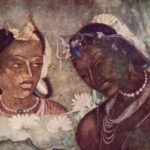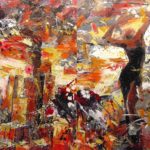India is country that has a splendid heritage of different cultures that have resulted in countless traditional art and crafts forms in every corner of this enormous country. Over the years, the art forms are responsible for a lot of the most dazzling Indian traditional dresses and art.
In several ways, Bengal may be seen as the focal point from which the Indian renaissance really started spreading its influence. From extremely early times, Bengal has prospered in quantity of art forms and cultural events nearly all of which have been reflected in its traditional rituals and celebrations. The art form that is famously referred to as the Alpona is primarily an attractive art found in common households of rural Bengal that has evolved over time.

Bengal Art
The Alponain Bengal
The ‘Alpona’ is one of most respected imaginative language and is a graphic artist. It was mainly painted on the borders of doors and windows and approximately the mud huts by village women to welcome the blessings of the Almighty and ward off wickedness at the similar time. It was also painted as a decoration on earthen pottery, cookware and on other terracotta work. The essential Alpona patterns use common motifs in a number of variations. Typically the feet of Goddess Lakshmi, the lotus flower, paddy leafs and other recognizable symbols of wealth are used but the art has been perfected by incorporating a lot of original elements in the design.

Alpana Border Design
The genuine alpona is a pattern in white as the main element used to paint is a combination of powdered rice in water. The reliability has to be such that it is neither too runny nor too rigid. The women do not use a brush and use their fingers skillfully to form designs on the selected surface.
The Rangoli in Bengal
In other parts of Bengal, the related art form is described to as the ‘rangoli’, the word being consequent from ‘rang’ which means colour. Unlike the typical alpona, rangoli traditionally is a riot of colours and the genuine designs are generally floral. Also, it generally uses colours in a crushed form or coloured flower petals as in Bengal.

Rangoli
Bengal school of art
The name works of this school of art were Bharat Mata’ by artist Abanindranath Tagore. ‘Bharat Mata’ was painted mainly in the unreliable shades of orange, saffron, and yellow, all creatures the colours of religion, sanctity, and Hindu religion. This work signified a personification of the holy strength of India, ‘Mother India,’ whom the Indians revered and worshipped as a Goddess.

Abanindranath Tagore, nephew of Nobel Laureate Rabindranath Tagore co-founded and forcefully promoted the Bengal School of Art during the untimely 20th century. This group felt that an authentic Indian style of painting must sketch the motivation from the non-western art tradition and should try to capture the religious essence of the East. So, these artists started doing experiments.
The best artist of Bengal school of art is Nirmal Dutta, Ganesh Pyne, Nilima Dutta and Asit Kumar Haldar. The artistic creed of this school was regularly challenged and fresh developments came about. An authentically individual search for content and form led to a winning fusion of Indian and European techniques.



What do you think?